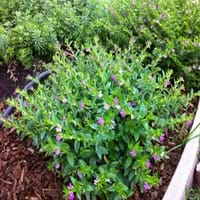Life Span
Perennial
Perennial
Type
Bulb or Corm or Tuber
Shrub
Origin
South America
Mexico, Central America
Types
Pamianthe cardenasii , Pamianthe parviflora , Pamianthe peruviana
Not Available
Number of Varieties
Not Available
Habitat
All sorts of environments
Tropical areas
USDA Hardiness Zone
8-10
9-15
Sunset Zone
21,22
H1, H2, 16, 17, 18, 19, 20, 21, 22, 23, 24
Habit
Clump-Forming
Cushion/Mound-forming
Flower Color
White
White, Pink, Light Pink, Lavender, Violet
Flower Color Modifier
Bicolor
Not Available
Fruit Color
Green
Non Fruiting Plant
Leaf Color in Spring
Dark Green
Light Green, Dark Green
Leaf Color in Summer
Light Green
Dark Green
Leaf Color in Fall
Several shades of Green
Dark Green
Leaf Color in Winter
Light Green
Dark Green
Leaf Shape
Strap shaped
Oblong to lance-shaped
Plant Season
Spring, Summer, Fall
Spring, Summer, Fall, Winter
Sunlight
Partial Sun, Partial shade
Full Sun, Partial Sun, Partial shade
Type of Soil
Loam, Sand
Clay, Loam, Sand
The pH of Soil
Acidic, Neutral, Alkaline
Acidic, Neutral, Alkaline
Soil Drainage
Average
Well drained
Bloom Time
Spring, Late Spring, Early Summer, Summer, Late Summer
Indeterminate
Tolerances
Drought
Drought
Where to Plant?
Ground, Pot
Ground, Pot
How to Plant?
Offsets
Cuttings, Divison, Layering, Seedlings
Plant Maintenance
Medium
Medium
Watering Requirements
Keep the ground moist but not water-logged
Needs watering once a week, Requires more often in extreme heat
In Summer
Lots of watering
Lots of watering
In Spring
Moderate
Moderate
In Winter
Average Water
Average Water
Soil pH
Acidic, Neutral, Alkaline
Acidic, Neutral, Alkaline
Soil Type
Loam, Sand
Clay, Loam, Sand
Soil Drainage Capacity
Average
Well drained
Sun Exposure
Partial Sun, Partial shade
Full Sun, Partial Sun, Partial shade
Pruning
Pinch or prune as they grow to promote branching and bushiness, Remove damaged leaves, Remove dead branches, Remove dead leaves, Requires little pruning
Prune if you want to improve plant shape
Fertilizers
All-Purpose Liquid Fertilizer, High phosphorus
14-14-14 Fertilizer
Pests and Diseases
Leaf spot, Mosaic viruses
Free of serious pests and diseases
Plant Tolerance
Drought
Drought
Flower Petal Number
Single
Single
Foliage Texture
Coarse
Medium
Foliage Sheen
Glossy
Glossy
Attracts
Bees, Birds, Bumblebees, Butterflies, Hummingbirds, pollinators
Butterflies
Allergy
Unknown
no allergic reactions
Aesthetic Uses
Beautification, Bouquets, Ornamental use, Showy Purposes
Borders, Ground Cover
Beauty Benefits
No Beauty Benefits
Not Available
Environmental Uses
Air purification
Air purification
Medicinal Uses
No Medicinal Use
Dysentry, Eye Infection, Indigestion, Organ Stones
Part of Plant Used
Not Available
Flowering Tips, Flowers, Leaves, Shoots, Stem
Other Uses
Beneficial species for attracting pollinators, Decoration Purposes
Showy Purposes
Used As Indoor Plant
No
Yes
Used As Outdoor Plant
Yes
Yes
Garden Design
Bog Garden, Container, Feature Plant, Foundation, Mixed Border, Water Gardens
Bedding Plant, Container, Edging, Foundation, Groundcover, Hanging Basket, Mixed Border
Botanical Name
HYMENOCALLIS longipetala
CUPHEA hyssopifolia
Common Name
Peruvian Daffodil, Spiderlily
False Heather, Mexican Heather, Hawaiian Heather
In Hindi
peruvian daffodil
Mexican Heather
In German
peruvian daffodil
Mexican Heather
In French
peruvian daffodil
Mexicaine Heather
In Spanish
Pamianthe
Heather mexicana
In Greek
peruvian daffodil
Μεξικού Heather
In Portuguese
peruvian daffodil
Mexican Heather
In Polish
peruvian daffodil
Mexican Heather
In Latin
peruvian daffodil
Mexicanus Heather
Phylum
Magnoliophyta
Magnoliophyta
Class
Liliopsida
Magnoliopsida
Order
Asparagales
Myrtales
Family
Amaryllidaceae
Lythraceae
Clade
Angiosperms, Monocots
Angiosperms, Eudicots, Rosids
Tribe
Clinantheae
Not Available
Subfamily
Amaryllidoideae
Lythroideae
Number of Species
Not Available
Not Available
Season and Care of Peruvian Daffodil and Mexican Heather
Season and care of Peruvian Daffodil and Mexican Heather is important to know. While considering everything about Peruvian Daffodil and Mexican Heather Care, growing season is an essential factor. Peruvian Daffodil season is Spring, Summer and Fall and Mexican Heather season is Spring, Summer and Fall. The type of soil for Peruvian Daffodil is Loam, Sand and for Mexican Heather is Clay, Loam, Sand while the PH of soil for Peruvian Daffodil is Acidic, Neutral, Alkaline and for Mexican Heather is Acidic, Neutral, Alkaline.
Peruvian Daffodil and Mexican Heather Physical Information
Peruvian Daffodil and Mexican Heather physical information is very important for comparison. Peruvian Daffodil height is 61.00 cm and width 61.00 cm whereas Mexican Heather height is 20.30 cm and width 30.40 cm. The color specification of Peruvian Daffodil and Mexican Heather are as follows:
Peruvian Daffodil flower color: White
Peruvian Daffodil leaf color: Dark Green
Mexican Heather flower color: White, Pink, Light Pink, Lavender and Violet
- Mexican Heather leaf color: Light Green and Dark Green
Care of Peruvian Daffodil and Mexican Heather
Care of Peruvian Daffodil and Mexican Heather include pruning, fertilizers, watering etc. Peruvian Daffodil pruning is done Pinch or prune as they grow to promote branching and bushiness, Remove damaged leaves, Remove dead branches, Remove dead leaves and Requires little pruning and Mexican Heather pruning is done Prune if you want to improve plant shape. In summer Peruvian Daffodil needs Lots of watering and in winter, it needs Average Water. Whereas, in summer Mexican Heather needs Lots of watering and in winter, it needs Average Water.





